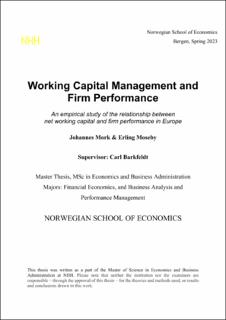Working Capital Management and Firm Performance : An empirical study of the relationship between net working capital and firm performance in Europe
Master thesis
Permanent lenke
https://hdl.handle.net/11250/3095524Utgivelsesdato
2023Metadata
Vis full innførselSamlinger
- Master Thesis [4372]
Sammendrag
Considering the magnitude of working capital as a proportion of a firm's total assets, working
capital management should interest corporate managers. We will, in our master's thesis,
examine if working capital management is value-enhancing. Our methods are based on Aktas
et al. (2014) 's study on US firms from 1982 to 2011. In comparison to Aktas et al. (2014), we
study the accounting data and stock performance from a sample of 7 725 listed European firms
in 15 countries from 2005 to 2021. Previous studies on the subject have found evidence of a
negative relationship between net working capital (NWC) and firm performance. The studies
suggest that firms should reduce their NWC level to increase firm performance. However,
because of differences in NWC level between firms within industries, it is not given whether
all corporate managers should decrease investments in NWC. We, therefore, examine the
existence of an optimal level of NWC to see if corporate managers can adjust NWC investment
to increase profitability and stock returns.
We answer this question by performing regression analyses on different performance measures.
Based on our empirical results, we find evidence of the existence of an optimal level of NWC.
Our findings show that corporate managers can adjust their NWC level to the optimal level of
NWC in their industry to increase profitability. By performing additional tests with different
profitability and time horizon measurements, we increase our findings' robustness. In addition,
Aktas et al. (2014) also found evidence of an optimal NWC level, which strengthens the
conclusion. However, compared to Aktas et al. (2014), our findings report a different effect for
firms with positive and negative excess NWC, whereas our results show a stronger effect for
firms with positive excess NWC. The results imply that corporate managers with a positive
excess NWC level should be especially interested in adjusting the NWC level closer to the
optimal level. In contrast to Aktas et al. (2014), we do not find evidence that NWC management
can increase stock performance.
